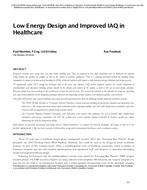Description
Hospitals consume more energy than any other major building type. They are required to have high ventilation rates to maintain the required IAQ (indoor air quality) for comfort as well as the control of airborne pathogens. There is a growing movement within the building design community to commit to carbon-neutral building by 2030, which for hospitals will require a shift from present day thinking and design practice. To significantly reduce EUI (energy use intensity) and at the same time improve IAQ within hospitals requires the careful integration of interdependent and synergistic building systems specific to the climate and context of the facility, as well as the use of novel design solutions. Research groups have been working on this problem for at least the last 10 years. The research has focused on the reduction of energy use, operating cost, and carbon footprint, whilst mitigating pathogen dispersal and improving thermal comfort, environmental quality, and resilience.
This paper will present some research findings and actual measured operating data from the following recently completed healthcare projects:
The 1930’s Willow Pavilion at Vancouver General Hospital, a newly renovated building for psychiatric inpatient and outpatient care, which uses a low energy concurrent mixed mode ventilation system (opening windows and vents with displacement ventilation and active exhaust) with an integrated heat pump energy transfer system.
The Nanaimo Regional Hospital Emergency and Psychiatric Care project that optimizes the use of natural light, displacement ventilation and natural ventilation. The HVAC system uses a novel dynamic thermal labyrinth to pretreat outside air, almost eliminating the need for mechanical cooling.
Both projects are presently operational and being used as “living laboratories” to validate the research, modeling, and design as well as to test possible improvements. IAQ has been assessed at both facilities using onsite measurement tracking as well as occupancy surveys.
Citation: IAQ Conference: IAQ 2013: Environmental Health in Low Energy Buildings
Product Details
- Published:
- 2013
- Number of Pages:
- 8
- File Size:
- 1 file , 720 KB
- Product Code(s):
- D-2013IAQConf-18




